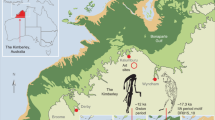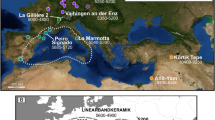A Jewish cemetery in ancient Rome harbours a secret that bears on the history of early Christianity.
Abstract
The famous catacombs of ancient Rome are huge underground cemeteries, of which two Jewish catacomb complexes of uncertain age and 60 early-Christian catacombs have survived1,2,3. Here we use radiocarbon dating to determine the age of wood originating from one of the Jewish catacombs and find that it pre-dates its Christian counterparts by at least 100 years. These results indicate that burial in Roman catacombs may not have begun as a strictly Christian practice, as is commonly believed1,3,4, but rather that its origin may lie in Jewish funerary customs.
Similar content being viewed by others
Main
The Jewish and Christian catacombs of Rome are all thought to date from the same general period — namely, from the early third century through to the early fifth century AD (refs 2,5) — but more precise dating has been difficult6,7. We therefore collected organic material for radiocarbon dating that had been incorporated during the construction of grave recesses (loculi) in the Jewish Villa Torlonia catacomb8,9 (Fig. 1, and see supplementary information).
For radiocarbon dates of samples taken from different construction sites, see supplementary information. Numbers refer to the sample origin; letter–number combinations refer to gallery number. Scale bar, 10 m.
Each loculus was sealed by a small wall of rubble and bricks that was covered in a smooth layer of lime. Pieces of charcoal from the limekiln that had been embedded in the lime were collected for dating. As young trimmings would have been the preferred wood for generating the high temperature (around 900 °C) necessary to effect the conversion of limestone to lime, we consider that contamination from mature or already dead wood is unlikely.
Fifteen samples from the five interconnected regions (A–E in Fig. 1) that make up the catacomb were subjected to radiocarbon analysis by atomic-mass spectroscopy10; absolute ages were determined for 2σ ranges by using the computer code Calib4 (ref. 11). Results from five damaged samples had to be discarded, but preliminary analysis of the remainder looked promising12.
Our analysis reveals a complete construction history of the upper and lower catacombs. The sequence of 2σ calendar ages ranges from 50 BC (from a sample at the entrance area to the lower catacomb) to AD 400 (sample from region A in the upper catacomb) (see supplementary information). Various charcoal samples were systematically identified as being derived from taxa known to be growing in the area during the time of the catacomb's construction13 (see supplementary information).
Our results are consistent with the chronological layout of the catacomb (Fig. 1). The oldest sample (number 1) derives from the entrance, the earliest construction point. Samples 3–6 from the D region fit the topographical development of the catacomb; the age of a painted arcosolium (arched grave) in the upper catacomb (sample number 7) is consistent with dating proposed on the basis of its style (AD 320–350; ref. 5;). The only sample that does not fit our chronology is number 10, which originates from a gallery that was dug into a pre-existing network of underground water tunnels.
This evidence indicates that the Villa Torlonia catacomb came into use in the second century AD, a century before the building of the earliest Christian catacombs started. Given that Roman Christianity evolved from Judaism, and Jews and Christians continued to interact until well into Late Antiquity, it is possible that Christian funerary practices were influenced by Jewish ones. This could explain the similarity between the oldest of the early Christian underground cemeteries and the Jewish Villa Torlonia catacomb, particularly considering that Callixtus, the deacon in charge of developing the Christian catacombs, came from the Jewish quarter. However, confirmation awaits radiocarbon dating of the Christian catacombs.
References
Fiocchi Nicolai, V. & Bisconti, F. & Mazzoleni, D. The Christian Catacombs of Rome: History, Decorations, Inscriptions (Schnell and Steiner, Regensburg, 1999).
Rutgers, L. V. Subterranean Rome (Peeters, Leuven, 2000).
Fiocchi Nicolai, V. Strutture Funerari ed Edifici di Culto Paleocristani di Roma dal IV al VI Secolo (Pontificia Commissione di Archeologia Sacra, Vatican City, 2001).
Pergola, P. Le Catacombe Romane. Storia e Topografia (Nuova Italia Editrice, 1997).
Rutgers, L. V. The Hidden Heritage of Diaspora Judaism (Leuven, Peeters, 1998).
Guyon, J. Boreas 17, 89–103 (1994).
Deckers, J. G. Studi di Antichità Cristiana 48, 217–238 (1992).
Fasola, U. M. Rivista di Archeologia Cristiana 52, 7–62 (1976).
Barbera, M. & Magnani Cianetti, M. in I Beni Cultualli Ebraici in Italia. Situazione Attuale, Problemi, Prospettive e Progetti per il Futuro (ed. Perani, M.) 55–70 (Longo Editore, Ravenna, 2003).
van der Borg, K. et al. Nucl. Instr. Meth. B 123, 97–101 (1997).
Stuiver, M. & Reimer, P. J. Radiocarbon 35, 215–230 (1993).
Rutgers, L. V., van der Borg, K. & de Jong, A. F. M. Radiocarbon 44, 541–547 (2002).
Fenaroli, L. Gli Alberi d'Italia (Aldo Martello Editore, Milan, 1967).
Author information
Authors and Affiliations
Corresponding author
Ethics declarations
Competing interests
The authors declare no competing financial interests.
Supplementary information
Rights and permissions
About this article
Cite this article
Rutgers, L., van der Borg, K., de Jong, A. et al. Jewish inspiration of Christian catacombs. Nature 436, 339 (2005). https://doi.org/10.1038/436339a
Published:
Issue Date:
DOI: https://doi.org/10.1038/436339a
This article is cited by
Comments
By submitting a comment you agree to abide by our Terms and Community Guidelines. If you find something abusive or that does not comply with our terms or guidelines please flag it as inappropriate.




